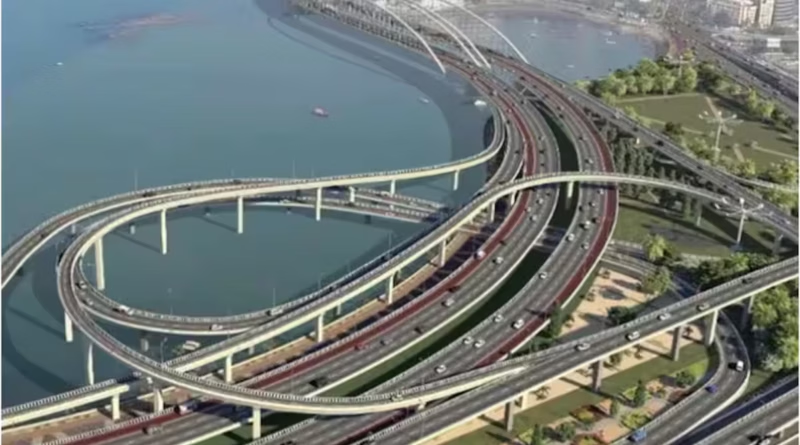Mumbai’s Coastal Marvel: Dharamveer Swarajya Rakshak Chhatrapati Sambhaji Maharaj Coastal Road
Mumbai has taken a monumental step in reshaping its urban transport landscape with the construction of the Dharamveer Swarajya Rakshak Chhatrapati Sambhaji Maharaj Mumbai Coastal Road. This state-of-the-art expressway, stretching along the city’s western seafront, aims to transform daily commutes and ease congestion across the city’s most densely populated corridors.
A Modern Coastal Expressway
The Coastal Road is an ambitious 29.2-kilometre, 8-lane grade-separated expressway connecting Marine Lines in South Mumbai to Kandivali in the northern suburbs. Designed to support up to 130,000 vehicles daily, the road promises to cut travel time between South Mumbai and the Western Suburbs from over two hours to just 40 minutes. The project is being developed at an estimated cost of ₹13,060 crore (approximately US$1.5 billion).
The first phase of the project, a 10.58 km stretch between Princess Street flyover and the Worli end of the Bandra-Worli Sea Link, was officially inaugurated on 11 March 2024.
From Vision to Reality
The idea of a coastal road was first proposed in 2012 by then Maharashtra Chief Minister Prithviraj Chavan as a more economical alternative to a series of expensive sea links. A Joint Technical Committee, headed by Municipal Commissioner Subodh Kumar, recommended a 35.6-kilometre road from Nariman Point to Kandivali. Their report advised against further sea link construction and projected savings of ₹12,000 crore by opting for a coastal road instead.
Engineering Feats and Land Reclamation[
One of the standout features of this project is its scale of land reclamation. The Coastal Road involves reclaiming 111 hectares from the sea—making it the largest land reclamation project in post-independence India. Of this:
- 26.5 hectares are dedicated to the road and interchanges,
- 14.5 hectares have been used for building a seawall,
- And a significant 70 hectares (63.6% of the reclaimed area) are being converted into green spaces and recreational areas.
Additionally, 4.35 km of the expressway is constructed on reclaimed land.
India’s First Undersea Tunnels
A major innovation in the Coastal Road is the construction of twin tunnels between Girgaon Chowpatty and Priyadarshini Park, each stretching 2.07 km. The north-bound tunnel is slightly shorter than the south-bound one due to curvature along the route.
The tunnels pass under some of Mumbai’s most iconic areas, including:
- Girgaon Chowpatty (14–15 meters below),
- Priyadarshini Park (20 meters below),
- And a section under Malabar Hill and the Hanging Gardens, reaching depths of 72 meters.
Notably, a 1-km stretch runs beneath the Arabian Sea, marking the creation of India’s first undersea tunnels. This engineering choice was made to preserve the heritage and views of the Queen’s Necklace, and to avoid security risks near the Raj Bhavan.
Project Timeline at a Glance
- July 2021: 90% land acquired; first 500 meters of tunnel completed.
- September 2021: 1-km tunnel boring achieved; 40% of project completed.
- December 2021: 2-km tunnel boring completed.
- January 2022: Tunnel boring fully completed.
- July 2022: Overall project 58% complete.
- May 2023: Officially named Dharamveer Swarajya Rakshak Chhatrapati Sambhaji Maharaj Coastal Road.
Looking Ahead
Once fully completed, the Coastal Road is expected to drastically decongest Mumbai’s existing arterial roads, improve air quality, and create more accessible green and recreational spaces for its citizens. It’s a bold statement of Mumbai’s infrastructure ambitions and a milestone in urban planning and engineering.
FAQs: Dharamveer Swarajya Rakshak Chhatrapati Sambhaji Maharaj Mumbai Coastal Road
1. What is the Mumbai Coastal Road Project?
The Mumbai Coastal Road is a major infrastructure project aimed at easing traffic congestion by creating a 29.2-kilometre, 8-lane expressway along Mumbai’s western coastline, from Marine Lines to Kandivali.
2. Why is it named ‘Dharamveer Swarajya Rakshak Chhatrapati Sambhaji Maharaj Coastal Road’?
The road was officially named in May 2023 to honor Chhatrapati Sambhaji Maharaj, the brave Maratha king and son of Chhatrapati Shivaji Maharaj, known for his valor and defense of Swarajya (self-rule).
3. What is the expected benefit of the Coastal Road?
The road is expected to:
- Reduce travel time from 2 hours to 40 minutes between South Mumbai and the Western Suburbs.
- Carry around 130,000 vehicles per day.
- Decrease traffic congestion on existing roads and improve overall air quality.
4. What is the total cost of the project?
The estimated cost is ₹13,060 crore (around US$1.5 billion).
5. What is the current status of the project?
As of March 2024, the first phase (10.58 km) from Princess Street flyover to Worli is completed and inaugurated. The rest of the project is in progress and will be completed in phases.
6. Is the road built on reclaimed land?
Yes. The project involves 111 hectares of land reclamation, making it the largest reclamation project in independent India. Around 70 hectares will be developed into green and recreational spaces.
7. Does the project include any tunnels?
Yes. It features twin tunnels (each about 2.07 km long) that run beneath Girgaon Chowpatty, Priyadarshini Park, and part of the Arabian Sea. These are India’s first undersea tunnels.
8. Why were tunnels chosen instead of a sea link in this area?
Tunnels were used to:
- Preserve the iconic view of the Queen’s Necklace.
- Protect the heritage feel of areas like Marine Drive and Chowpatty.
- Avoid security concerns near sensitive zones like Raj Bhavan.
9. What kind of public spaces are included in the project?
About 63.6% of the reclaimed land will be transformed into green spaces, parks, promenades, and cycling tracks, offering much-needed recreational areas to Mumbaikars.

